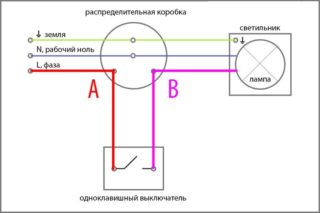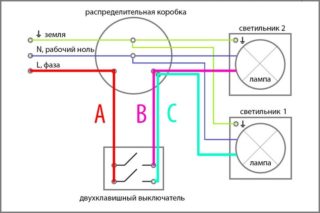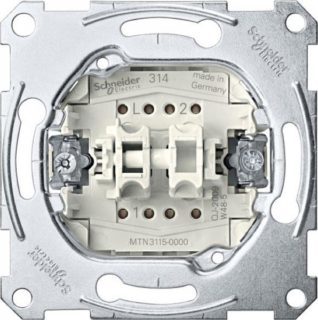For various firms that produce electrical products, the type designations on the contacts of the light switches may not coincide. You need to figure out what L stands for on the light switch and if there are any other designations. This knowledge will help all interested parties, after purchasing the installation product, to correctly connect it to the current power supply.
Connection features

To understand the features of connecting a standard switch, you will need to study the principle of its operation. As an example, convenient for description, a variety of devices with one key is selected.
- the switch is always installed in a break in the phase wire, the second end of which is led either to the junction box or directly to the luminaire;
- there are only two wires on both sides, and each of them is intended for its own purposes;
- one of them is laid up to the circuit breaker from the line circuit breaker and is constantly energized;
- it is absent on the second wire, which is why the lighting device connected to the switch does not light up.
Mains 220 Volts are supplied to it only after pressing a button or key when switching it to the "On" mode. After that, a working lamp or light bulb immediately lights up.
When connecting a three-button switch, the distribution of the functions of each of the contacts is the same. But in this case, on the side of the conductor outlet to the junction box or chandelier, there are two contacts that serve to switch different groups of light bulbs. Accordingly, the number of designations becomes larger by one. The same is observed when using a three-key product, in which the number of contacts and outgoing conductors is increased by one more. Knowledge of these features of the switching device will help to decipher the L marking on the switch.
What does L stand for
Conventional designations on light switches are applied to mark their pin connectors or to indicate the position in which their key is located.
The contact to which the phase is supplied from the switchboard has the designation L on the switches for all types of devices - both single-key and multi-key.

Presumably, this symbol is taken from the first letter of the English word "Line", meaning line or line wire. The second contact also has its own designation, which is different for different manufacturers:
- The letter L with the addition of one to it is L1.
- The same sign, but with the addition of a stroke - L`.
- Small arrow pointing up.
- Just one ("1").
For a number of manufacturers, this branch is not indicated at all. If it is on top, a wire is diverted from it to the chandelier or junction box.

The PUE stipulates from which sides the conductors should be supplied and removed to the switch. According to the requirements of the standards, the connection is made from below, and the branch is mounted from above.
For two-key and three-key devices, the number of outgoing conductors increases to two and three, respectively, which forces their manufacturers to mark additional contacts. Therefore, their designations often include such icons as L2, L3 or the same letter, but with two or three strokes.It is also possible that, instead of letters, there are only numbers next to the output terminals that correspond to the number of the outgoing conductor.
How the output contacts are connected
The order of actions with each type of switch can be represented as the following algorithm:
- in the case of a one-key version, the switch has L and L1 - this means that only one outgoing conductor is connected to the output;
- in a two-key analog, they will have to be alternately connected to each of the output terminals, and watch which of the illuminators lights up. Based on the experimental data, the required contacts are selected under the designations L1 and L2;
- in a three-key sample, the possibilities are expanded: you will have to go through the connection order many times (the number of combinations of three options is 6).
It is possible to simplify the last operation by alternately connecting the "unidentified" outgoing conductors with a phase conductor and observing which bulbs, groups or lamps light up.
Each time after connecting the next wire and defining a group of illuminators, this tap is connected to the terminal chosen specifically for the tested consumer. After that, the control function of this circuit is automatically transferred to the key, the switching mechanism of which is associated with this contact.
Body designations

In addition to the L designation on the lighting switch, other symbols and icons are found at its working contacts or on the housing.
Most often, manufacturers use the symbolic principle of marking two states of a switching device - on and off. The intuitive zero and one ("0" and "1") are traditionally used as such symbols. The first one corresponds to the "Off" or "OFF" state and is located in the lowest zone of the electrical appliance body. The second icon stands for Enabled (ON) and is applied at the top. There are also such rare designations as arrows indicating the direction of commutation.
Having become familiar with what L is on the room light switch, everyone can independently connect it to the current power supply. In case of emergency, the defective device can be repaired. This will also be helped by the ability to understand the differences in markings for different types of switches produced by different manufacturers.










Guys, these are pass-through switches, they are installed in two, three pieces in the room, so that from any point, you can control the lighting in the room.
I connected it according to the scheme. Everything works as it should. Thank you